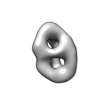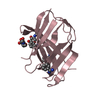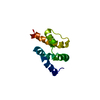+ Open data
Open data
- Basic information
Basic information
| Entry | Database: EMDB / ID: EMD-11831 | |||||||||
|---|---|---|---|---|---|---|---|---|---|---|
| Title | BIP18SN. De novo coiled-coil-based bipyramidal protein | |||||||||
 Map data Map data | Coiled coil single chain protein origami bipyramid composed of dimeric coiled coil segments. | |||||||||
 Sample Sample |
| |||||||||
 Keywords Keywords | coiled coil protein origami / DE NOVO PROTEIN | |||||||||
| Biological species |  | |||||||||
| Method | single particle reconstruction / negative staining / Resolution: 25.0 Å | |||||||||
 Authors Authors | Lapenta F / Aupic J / Vezzoli M / Strmsek Z / Da Vela S / Svergun DI / Melero R / Carazo JM / Jerala R | |||||||||
| Funding support | European Union, 1 items
| |||||||||
 Citation Citation |  Journal: Nat Commun / Year: 2021 Journal: Nat Commun / Year: 2021Title: Self-assembly and regulation of protein cages from pre-organised coiled-coil modules. Authors: Fabio Lapenta / Jana Aupič / Marco Vezzoli / Žiga Strmšek / Stefano Da Vela / Dmitri I Svergun / José María Carazo / Roberto Melero / Roman Jerala /     Abstract: Coiled-coil protein origami (CCPO) is a modular strategy for the de novo design of polypeptide nanostructures. CCPO folds are defined by the sequential order of concatenated orthogonal coiled-coil ...Coiled-coil protein origami (CCPO) is a modular strategy for the de novo design of polypeptide nanostructures. CCPO folds are defined by the sequential order of concatenated orthogonal coiled-coil (CC) dimer-forming peptides, where a single-chain protein is programmed to fold into a polyhedral cage. Self-assembly of CC-based nanostructures from several chains, similarly as in DNA nanotechnology, could facilitate the design of more complex assemblies and the introduction of functionalities. Here, we show the design of a de novo triangular bipyramid fold comprising 18 CC-forming segments and define the strategy for the two-chain self-assembly of the bipyramidal cage from asymmetric and pseudo-symmetric pre-organised structural modules. In addition, by introducing a protease cleavage site and masking the interfacial CC-forming segments in the two-chain bipyramidal cage, we devise a proteolysis-mediated conformational switch. This strategy could be extended to other modular protein folds, facilitating the construction of dynamic multi-chain CC-based complexes. | |||||||||
| History |
|
- Structure visualization
Structure visualization
| Movie |
 Movie viewer Movie viewer |
|---|---|
| Structure viewer | EM map:  SurfView SurfView Molmil Molmil Jmol/JSmol Jmol/JSmol |
| Supplemental images |
- Downloads & links
Downloads & links
-EMDB archive
| Map data |  emd_11831.map.gz emd_11831.map.gz | 3.5 MB |  EMDB map data format EMDB map data format | |
|---|---|---|---|---|
| Header (meta data) |  emd-11831-v30.xml emd-11831-v30.xml emd-11831.xml emd-11831.xml | 8.8 KB 8.8 KB | Display Display |  EMDB header EMDB header |
| Images |  emd_11831.png emd_11831.png | 25.1 KB | ||
| Filedesc metadata |  emd-11831.cif.gz emd-11831.cif.gz | 3.7 KB | ||
| Archive directory |  http://ftp.pdbj.org/pub/emdb/structures/EMD-11831 http://ftp.pdbj.org/pub/emdb/structures/EMD-11831 ftp://ftp.pdbj.org/pub/emdb/structures/EMD-11831 ftp://ftp.pdbj.org/pub/emdb/structures/EMD-11831 | HTTPS FTP |
-Validation report
| Summary document |  emd_11831_validation.pdf.gz emd_11831_validation.pdf.gz | 398.7 KB | Display |  EMDB validaton report EMDB validaton report |
|---|---|---|---|---|
| Full document |  emd_11831_full_validation.pdf.gz emd_11831_full_validation.pdf.gz | 398.3 KB | Display | |
| Data in XML |  emd_11831_validation.xml.gz emd_11831_validation.xml.gz | 4.2 KB | Display | |
| Data in CIF |  emd_11831_validation.cif.gz emd_11831_validation.cif.gz | 4.9 KB | Display | |
| Arichive directory |  https://ftp.pdbj.org/pub/emdb/validation_reports/EMD-11831 https://ftp.pdbj.org/pub/emdb/validation_reports/EMD-11831 ftp://ftp.pdbj.org/pub/emdb/validation_reports/EMD-11831 ftp://ftp.pdbj.org/pub/emdb/validation_reports/EMD-11831 | HTTPS FTP |
-Related structure data
| Similar structure data |
|---|
- Links
Links
| EMDB pages |  EMDB (EBI/PDBe) / EMDB (EBI/PDBe) /  EMDataResource EMDataResource |
|---|---|
| Related items in Molecule of the Month |
- Map
Map
| File |  Download / File: emd_11831.map.gz / Format: CCP4 / Size: 3.8 MB / Type: IMAGE STORED AS FLOATING POINT NUMBER (4 BYTES) Download / File: emd_11831.map.gz / Format: CCP4 / Size: 3.8 MB / Type: IMAGE STORED AS FLOATING POINT NUMBER (4 BYTES) | ||||||||||||||||||||||||||||||||||||||||||||||||||||||||||||
|---|---|---|---|---|---|---|---|---|---|---|---|---|---|---|---|---|---|---|---|---|---|---|---|---|---|---|---|---|---|---|---|---|---|---|---|---|---|---|---|---|---|---|---|---|---|---|---|---|---|---|---|---|---|---|---|---|---|---|---|---|---|
| Annotation | Coiled coil single chain protein origami bipyramid composed of dimeric coiled coil segments. | ||||||||||||||||||||||||||||||||||||||||||||||||||||||||||||
| Voxel size | X=Y=Z: 1 Å | ||||||||||||||||||||||||||||||||||||||||||||||||||||||||||||
| Density |
| ||||||||||||||||||||||||||||||||||||||||||||||||||||||||||||
| Symmetry | Space group: 1 | ||||||||||||||||||||||||||||||||||||||||||||||||||||||||||||
| Details | EMDB XML:
CCP4 map header:
| ||||||||||||||||||||||||||||||||||||||||||||||||||||||||||||
-Supplemental data
- Sample components
Sample components
-Entire : Coiled-coil-based protein monomer
| Entire | Name: Coiled-coil-based protein monomer |
|---|---|
| Components |
|
-Supramolecule #1: Coiled-coil-based protein monomer
| Supramolecule | Name: Coiled-coil-based protein monomer / type: complex / ID: 1 / Parent: 0 |
|---|---|
| Source (natural) | Organism:  |
-Experimental details
-Structure determination
| Method | negative staining |
|---|---|
 Processing Processing | single particle reconstruction |
| Aggregation state | particle |
- Sample preparation
Sample preparation
| Concentration | 0.03 mg/mL |
|---|---|
| Buffer | pH: 7.5 |
| Staining | Type: NEGATIVE / Material: uranyl acetate |
| Details | Samples were applied to glow discharged carbon-coated copper grids, washed quickly with distilled water and negatively stained with 2% (w/v) uranyl acetate. |
- Electron microscopy
Electron microscopy
| Microscope | JEOL 1230 |
|---|---|
| Image recording | Film or detector model: TVIPS TEMCAM-F415 (4k x 4k) / Average electron dose: 20.0 e/Å2 |
| Electron beam | Acceleration voltage: 120 kV / Electron source: TUNGSTEN HAIRPIN |
| Electron optics | Calibrated magnification: 54926 / Illumination mode: FLOOD BEAM / Imaging mode: BRIGHT FIELD |
| Sample stage | Specimen holder model: JEOL |
- Image processing
Image processing
| Startup model | Type of model: OTHER |
|---|---|
| Final reconstruction | Resolution.type: BY AUTHOR / Resolution: 25.0 Å / Resolution method: FSC 0.143 CUT-OFF / Number images used: 20000 |
| Initial angle assignment | Type: ANGULAR RECONSTITUTION |
| Final angle assignment | Type: ANGULAR RECONSTITUTION / Software - Name: Xmipp |
-Atomic model buiding 1
| Refinement | Protocol: RIGID BODY FIT |
|---|
 Movie
Movie Controller
Controller



 UCSF Chimera
UCSF Chimera






